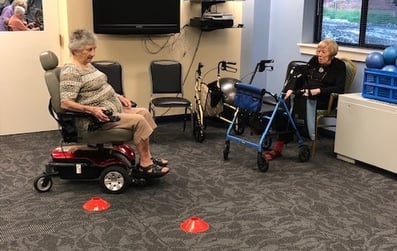 There isn’t anything easy about it. Residents were put to the test during Active Aging Week 2018 by completing an electric wheelchair obstacle course. An electric wheelchair is quite an intimidating assisted device that many residents around the building use to navigate the building. This was a great chance to see how residents could handle themselves in a situation where an electric wheelchair might be a last effort chance to remain independent and mobile.
There isn’t anything easy about it. Residents were put to the test during Active Aging Week 2018 by completing an electric wheelchair obstacle course. An electric wheelchair is quite an intimidating assisted device that many residents around the building use to navigate the building. This was a great chance to see how residents could handle themselves in a situation where an electric wheelchair might be a last effort chance to remain independent and mobile.
The primary goal of this activity was for residents to see how life felt in someone else’s shoes for a moment. Electric wheelchairs aren’t always an ideal way to get around. Sure, it might get you from point A to point B in a shorter amount of time, but they often get looked down upon for “taking the easy way out.” Is it really the easy way out? The only easy thing about it seemed to be the fact that one could sit down in the process. Residents were quick to find out how much dexterity and fine motor skills are involved in steering this battery operated device.
Cones were set up in a large circle in the center of the room. Residents were instructed to drive around the circle as close to the cones as possible. When they made it the entire way around, they turned into the circle between two cones, without hitting them, and circled the cones in the opposite direction. Following the completion of the change of direction, the residents were instructed to pull between two cones that were located against the wall. This exercise was designed to simulate pulling between two chairs at the dinner table. They had to stop before the wheelchair crashed into the table (in this case, the wall). Then they had to back up as straight as possible and drive back to the starting position to exchange with the next resident in line.
All of the residents noted how fidgety the steering component was on the device. It didn’t always move in the exact manner they intended. The wheels are located in the back of the chair, which produces a much smaller turning radius that threw the residents for quite a loop. Some had trouble with speed control. Some had trouble with backing up. Everyone had their own complaints or pains about using the wheelchair for those 5 minutes.
Overall, the consensus was the same. Everyone enjoyed the experience, but knew they didn’t want to use the chair full time. Each person spoke about the stigma that came with using an electric wheelchair in public. Many residents would jump to the other side of the room when someone approached them in the chair because they thought they were too dangerous. Now the hope is that people will be more considerate and thoughtful towards those residents confined to a chair for mobility and independence.


.jpg?width=438&name=Lung%20health%20GettyImages-961715338%20(1).jpg) COPD (Chronic Obstructive Pulmonary Disease) is a disease that makes it hard to breathe and, according to the
COPD (Chronic Obstructive Pulmonary Disease) is a disease that makes it hard to breathe and, according to the 
.jpg?width=381&name=Bored%20with%20exercise%20-%20girls%20GettyImages-844164510%20(1).jpg)